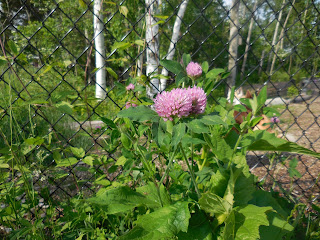Litter-sisters Totty and Pila had a tiff while Iris was here. Her front left leg was injured which required a trip to the vets for Pila. She's fine; a little fluid and swelling but no stitches, no blood, and an x-ray was taken to be sure. Kennel-dad stayed with her the whole time which was interesting. Clicking on photos enlarges them.
Evening primrose (Oenothera fruticosa)
I've introduced several native kinds of flowers into my small prairie here; it's exciting, for me anyway, to see a few of them making an attempt to flower this summer. The old maxim is: - "Sleep, creep, leap". That refers to the first three years of growth after planting. Perennials are very slow to get established (sleep) and seem not to be doing anything their first year. The second year they have survived and may look a bit larger (creep). By the third year they take off and make a much better show (leap). I'm hoping that will be the case here.
Clover, daisies
Rosa rugosa
Because there are no good nurseries and greenhouses here, I have become good friends with plant catalog companies. I had some trepidations about buying bare root trees and shrubs because I'd never done that. When you have good nurseries nearby, you get a good looking potted plant with well established roots which makes transplanting easy.
Virtually all of my roses, shrubs, and trees have come bare root. I planted them immediately upon arrival and waited, sometimes for many months. I'm converted. Virtually all of them made it. Most are doing very well. A few got off to a slow start but at least they survived. It has been fun watching and waiting for growth. I would not hesitate now to buy most shrubs and trees bare root.
Tradescantia occidentalis
Daisies
I have tried in the past to grow Shasta daisies; they do fine the first summer and maybe even the second one but they are, like many hybridized plants, not long lived. They are what I call - "picky eaters" - because they just don't last for years - often. Wild daisies look as nice, in my opinion, and are tough!
Clivia - flowering again
I think my Clivia love the light they're getting here. (Thank you for my windows Brian.) Some have flowered twice or thrice in the short year that I've been here. In the past I was lucky if I got one flower stalk per plant a year.
Yellow Clivia - n.b. the yellow seeds on the upper right
Those two seeds have been growing for about a year and a half. They are being nurtured by a direct connection to the mother plant which will give the seedlings a head start on life when they finally separate. The larger of the two seeds shown above has a bump on the bottom which will eventually become the new root. Mammals also nurture their young before they are born as do several species of fish, etc. We are not alone in the care and head-start given to offspring. Very cool to see that other organisms do what we do. We were not the first or the only species to give that "legs up" to offspring.













No comments:
Post a Comment